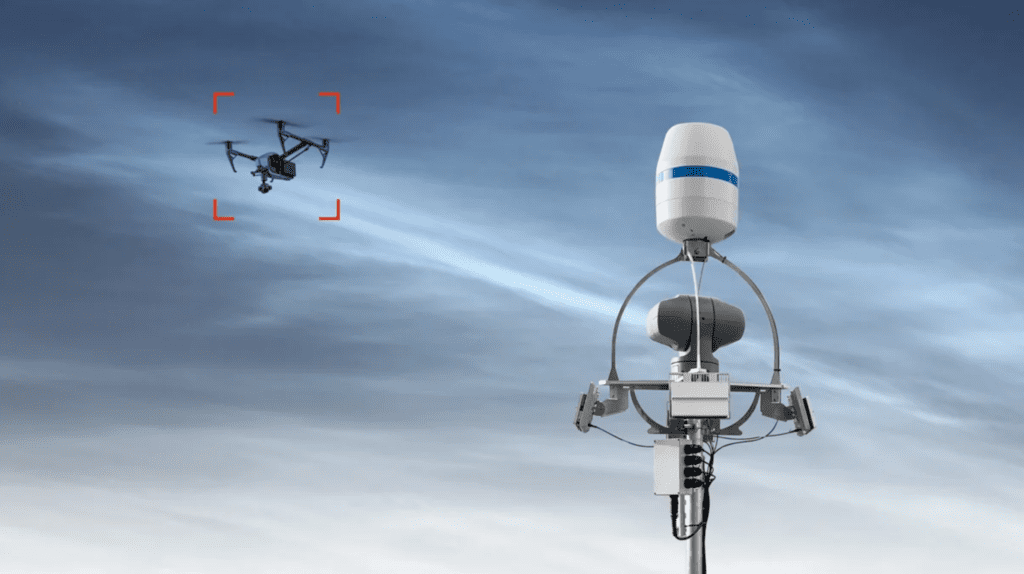The Most Popular Anti Drone Equipment
Industry Background
System Composition
Detection System
RF Detection System
Radar Detection System
Electron Optic Tracking System(EOTS)
Counter System
Soft-kill Equipment
Глушилка для дронів
Drone Spoofer
Hard-kill Equipment
Laser Gear
Industry Background
With the rapid development of artificial intelligence, communication technology and aeronautical engineering technology, the application range of Uavs is more and more extensive. From commercial use to military operations, drones have become an integral part of modern society.

As you can see from Figure 1, the global UAV market shows a continuous upward trend. This also means that we will face the potential risks of more and more drones. In order to strengthen the management of Uavs, the United States, China, Japan and the European Union have successively introduced the management regulations of Uavs RID. However, the simple RID mode may fail in the face of unauthorized UAV flight activities. Therefore, we need a more comprehensive anti drone solution. Such as radar and optoelectronics, and soft kill systems and hard kill systems.
System Composition
Before we begin our description of an anti-drone system, I have two questions:
- How to find a drone?
- How to attack a drone?

This is the central issue in which we build our anti Uas system.
We start with the first question, “how to find a drone”. Right now, the first thing that probably comes to mind is radar. Indeed, radar also plays an important role in drone detection. In drone detection, phased array radar is mainly used. In addition to radar, there are RF detection devices and optoelectronic tracking devices. Each of these devices can run independently or be used together to complement each other.So, you can decide which of these devices to buy according to your financial budget. Buying everything is the best choice, and if you have limited funds, then choosing an RF detection system will be the best choice.

After solving the problem of how to detect drones, let’s talk about “how to attack a drone”. Firstly we divide the anti-UAV methods into soft-kill and hard-kill methods.In everyday applications, the most common are soft-kill devices, such as drone jamming device and GNSS spoof equipment. Hard kill generally refers to physical destruction, such as laser.
Why do more people choose soft kill?
Because the use of electromagnetic wave interference soft kill equipment is more simple, the price is cheaper, in the volume and weight are relatively more appropriate.
However, the soft killing method has some defects, which may be invalid for special Uavs with strong anti-jamming ability. This is where the hard kill comes in. However, soft kill can basically deal with the vast majority of Uavs at present, so soft kill equipment plays a very important role in anti-drone. Do not look down on soft kill equipment, the current market soft kill equipment can cover all the UAV communication frequency band.
Laser as the most powerful means of hard killing, the drone must not ignore its existence. One might wonder why not shoot the drone without a gun, wouldn’t that be better? You have to know that it is very difficult to hit a target with a fast flying drone operated by a human. The laser equipment is guided to complete the target aiming action through the data of the detection equipment. The disadvantages of lasers are that they are expensive, complex and have a limited range.
The above devices can be gathered together to form a complete anti-UAV system to realize the task of finding and then countering Uavs. This is the answer to the two questions I mentioned earlier. I will introduce the specific device content from these two aspects. I will introduce the specific equipment content from these two aspects, one is the detection system, and the other is the counter system.
Detection System
RF Detection
What is spectrum detection:
Spectrum sensing technology is a technology to identify, measure and locate radio signals by analyzing the distribution and characteristics of signals in the frequency domain. In the UAV spectrum detection equipment, the spectrum detection technology is mainly used to monitor and analyze the air radio signal in real time, so as to obtain the key parameters such as frequency, bandwidth and power of the signal.
The advantges of RF detection:
- Passive detection, do not actively transmit signals
- Radio waves travel far enough to cover a large area
- It can realize high-precision positioning of the UAV
- The cost of radio detection is very low compared to radar, optoelectronic, acoustic and other UAV detection technologies
The disadvantages of RF detection:
- Signal encryption is difficult to crack
- Vulnerable to electromagnetic interference
- The FPV is difficult to locate
Radar Detection
What is phased array radar:
Phased-array radar is phase-controlled electronically scanned array radar. Its ability of fast and precise beam conversion enables the radar to complete the scanning of the whole space within 1 minute. The so-called phased array radar is a radar array composed of a large number of identical radiation elements. Each radiation element
is independently controlled by the wave controller and phase shifter in phase and amplitude, which can obtain accurate and predictable radiation pattern and beam direction.
The anti-Uas radar mainly detects “low small slow” targets, often using X and Ku band, and synthesizes dual-polarization fully coherent, intelligent radar data processing, multi-source data fusion and other technologies, which can realize all-weather, active, multi-target and fine detection of “low and small slow targets” + “low altitude micro-meteorological” targets.
The advantages of radar detection:
- Fast scanning speed, flexible and controllable beam
- Long detection range
- The target capacity is large, and hundreds of targets can be monitored and tracked simultaneously in the airspace
- Strong anti-interference capability
- Strong adaptability to complex target environment
- High reliability
The disadvantages of radar detection:
- High cost
- Equipment is complex
- There are blind spots at close range
- The beam scanning range is limited
Electron Optic Tracking System(EOTS)
What is electron optic tracking system:
Optoelectronic identification and tracking equipment combines visible light and infrared imaging technology, collects the optical information of the target through the optical system, and converts it into electrical signals for processing and analysis, so as to realize the rapid and accurate identification and tracking of the target.
The advantages of electron optic tracking system:
- High definition camera, high precision
- Strong object recognition ability
- Real-time image transmission
- Automatic target tracking
The disadvantages of electron optic tracking system:
- Affected by the environment
- Technical sophistication
- Strong hardware dependency
- Optical cameras are more expensive
Counter System
After detecting the drone through the detection system, it is necessary to solve the problem of how to defend the drone. The ways to defend Uavs are usually divided into two main categories, namely soft kill and hard kill. Soft kill is mainly achieved through electronic technology, while hard kill uses physical destruction. At present, the most common is soft-kill technology, because it is better cost performance and less difficult to implement. Soft kill technology applies electromagnetic wave technology to interfere with the remote control signal and video transmission signal of UAV by transmitting the same frequency signal. The technology was first used in drone jamming devices, and then spawned into drone spoofing devices.The market is flooded with drone jamming devices, and let’s discuss this one first. Then, let’s look at drone decoy devices.
Глушилка для дронів
What is the drone jammer:
Using high-frequency electromagnetic wave technology, the electromagnetic wave is transmitted in the same frequency band as the UAV communication band, which interferes with the UAV receiving instructions on the remote control, resulting in the UAV being unable to parse instructions and video signals on the remote control normally, thus losing control and returning or landing according to the preset procedure.
Usually, we classify jammers into several categories according to their structure, namely stationary jammers, backpack jammers, and handheld jammers. Below I have listed a few images that correspond to each of these types.
You need to decide which structure of the interference device to choose according to your specific use case. (How to choose a suitable jammer?)
The advantages of drone jammer:
- The price is cheap. High cost performance
- It can cover multiple communication frequency bands
- Jamming multiple targets simultaneously
The disadvantages of drone jammer:
- The interference distance is limited
- High equipment power
- No direct damage is caused to the drone, which can only force the droneto return to its departure point or land safely in place.
Drone Spoofer
What is the drone spoofer:
By sending misleading GPS signals, the drone can not accurately obtain position information, resulting in its positioning offset or loss of navigation ability.
The market is mainly stationary spoofing equipment and portable spoofing equipment. There is not much difference in the structure of the GNSS spoof device, what we need to be concerned about is that it covers the signals of several satellite positioning systems. We know the mainstream of the four major global positioning systems: GPS, Beidou, Galileo, Glonass. In general, we need signals from all four systems. Because common Uavs have at least two GNSS locators, many of DJI’s Uavs, for example, may have three or even four locators. So in order to be foolproof, it’s best that our spoofing device covers all 4 major GNSS.
The advantages of drone spoofer:
- Low device power consumption
- It can directly affect the flight of the drone, and even cause the droneto crash.
- The coverage is larger than that of jammer
The disadvantages of drone spoofer:
- The price is relatively more expensive than jammer
- Unable to cope with dronewithout GNSS capabilities
- It affects the GNSS functionality of all devices in the area


